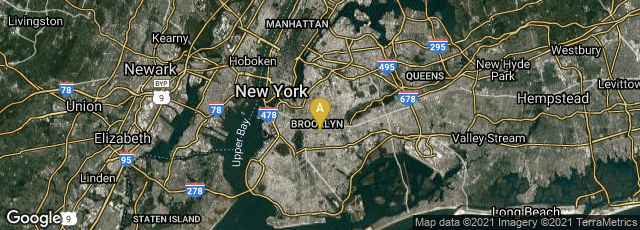

A: Brooklyn, New York, United States
Camera lenses of the 1880s were slow, as was the emulsion on photographic plates— the technology used before film negatives. Thus photographers could not take pictures in the dark or in most interior scenes. However, in early 1887 Danish American social reformer, journalist and photographer Jacob Riis of New York learned that flash powder, a mixture of magnesium with potassium chlorate and antimony sulfide for added stability, could be used in a pistol-like device that fired cartridges, for flash photography. Using this technology Riis illustrated his book entitled How the Other Half Lives: Studies among the Tenements of New York, published in 1890.
"The title of the book is a reference to a sentence by French writer François Rabelais, who famously wrote in Pantagruel: "one half of the world does not know how the other half lives" ("la moitié du monde ne sait pas comment l'autre vit").
"In How the Other Half Lives Riis describes the system of tenement housing that had failed, as he claims, due to greed and neglect from wealthier people. He claims a correlation between the high crime rate, drunkenness and reckless behaviour of the poor and their lack of a proper home. Chapter by chapter he uses his words and photographs to expose the conditions inhabited by the poor in a manner that “spoke directly to people's hearts”.
"He ends How the Other Half Lives with a plan of how to fix the problem. He asserts that the plan is achievable and that the upper classes will not only profit financially from such ventures, but have a moral obligation to tend to them as well.
"How the Other Half Lives: Studies among the Tenements of New York explained not only the living conditions in New York slums, but also the sweatshops in some tenements which paid workers only a few cents a day. The book explains the plight of working children; they would work in factories and at other jobs. Some children became garment workers and newsies (newsboys).
"The effect was the tearing down of New York's worst tenements, sweatshops, and the reformation of the city's schools. The book led to a decade of improvements in Lower East Side conditions, with sewers, garbage collection, and indoor plumbing all following soon after, thanks to public reaction" (Wikipedia article on How the Other Half Lives, accessed 01-12-2013).
My attention to Riis's book was drawn by an article published in The New York Times on January 11, 2014 by journalist Ted Gup, entitled "The 1890 Book I Had to Have." It described Gup's experience in 2009-2010 buying the author's annotated copy of Riis's How the Other Half Lives, his appreciation of the unique copy, and the book's relevance to socio-economic problems today.
In January 2014 an audio version of Riis's complete book was available from LibriVox.org at this link.